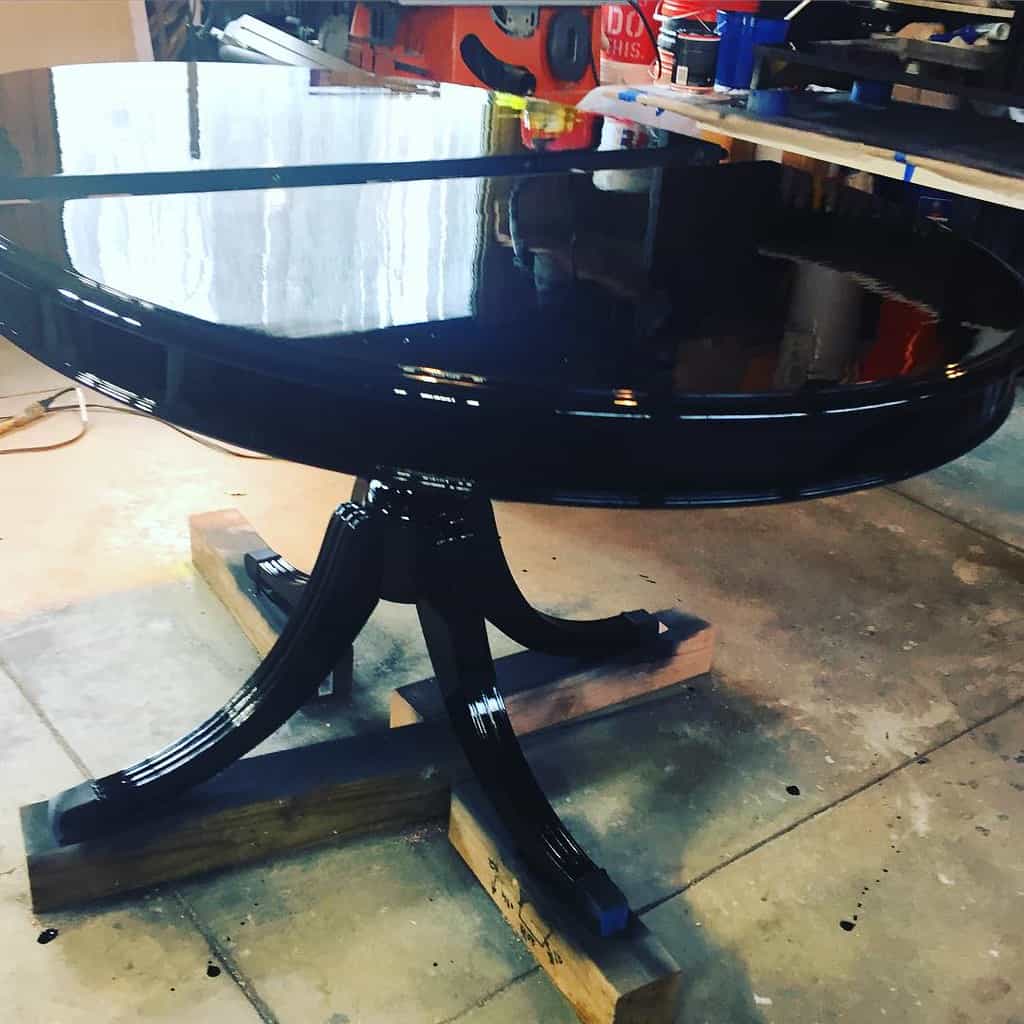Painting a table with a glossy finish can seem daunting. Many people worry about how to prep the surface. They want to make sure the new paint will stick and look good.
You need to prepare a glossy table before painting it. The smooth surface makes it hard for paint to grip. But don’t worry! There are easy ways to get your table ready for a fresh coat of paint.
Deglossing or sanding are common ways to prep glossy furniture. These methods rough up the surface so paint can stick better. Some people also use primer to help the paint adhere. With the right prep your table will look great with its new paint job.
Image Credit: https://www.flickr.com/photos/82705783@N00/23713984131
Surface Preparation for Painting Furniture
Getting a table ready for painting takes some work. It’s key to clean and smooth the surface first. You may also need to fix any damage.
Cleaning and Degreasing
Start by cleaning the table well. Use soap and water to remove dirt and grime. For tough grease, try a degreaser. Wipe the surface with a damp cloth after cleaning.
Let the table dry fully. Use a tack cloth to pick up any dust. This sticky cloth helps grab tiny bits of debris.
A clean surface helps paint stick better. It also gives a smoother finish.
Sanding and Smoothing
Sanding helps paint grip the surface. Use medium-grit sandpaper for most tables. Sand in the direction of the wood grain.
For glossy finishes, light sanding is often enough. This creates tiny scratches for paint to cling to.
After sanding, wipe away all dust. You can use a vacuum or shop vac for this. Then go over it again with a tack cloth.
Repairing Damage
Check the table for any flaws. Fill small cracks or holes with wood filler. Let it dry, then sand it smooth.
For bigger issues, you might need to patch or replace parts. Fix any loose joints or wobbly legs.
Sand repaired areas to blend with the rest of the table. This gives an even base for painting.
Consider using a primer on bare wood or repaired spots. It helps the paint look more even.
Paint Application Techniques
Getting a smooth glossy finish takes skill and the right methods. Here are some key steps to apply paint to your table.
Priming for Glossy Finishes
Priming is crucial for a glossy finish. It helps the paint stick better. Use a bonding primer made for glossy surfaces. Apply it with a foam roller for a smooth base.
Let the primer dry fully. This can take a few hours. Once dry, sand it lightly with fine sandpaper. Wipe off any dust with a tack cloth.
Priming helps stop stains from showing through. It also makes the final paint color look better.
Choosing the Right Paint
Pick a paint made for furniture. Gloss or semi-gloss works well for tables. Oil-based paints give a very smooth finish. But they take longer to dry.
Water-based paints are easier to use. They dry faster and clean up with soap and water. Look for paints labeled “enamel” for extra durability.
Test the paint on a small hidden spot first. This lets you check the color and finish.
Applying the Final Coat
Use a foam roller or brush to apply thin, even coats. Don’t overload the brush. This can cause drips. Work in small sections.
Let each coat dry fully before adding the next one. Light sanding between coats helps smooth out any bumps.
Most tables need 2-3 coats for full coverage. The last coat is key for a smooth finish. Apply it carefully and evenly.
A paint sprayer can give a very smooth finish. But it takes practice to use one well.
Let the paint cure fully before using the table. This can take a week or more for some paints.
Frequently Asked Questions
Painting glossy furniture requires careful preparation and the right materials. Here are some common questions about this process.
What is the best type of paint to use on high gloss furniture?
For glossy furniture, use paint made for slick surfaces. Chalk paint sticks well to glossy finishes. Acrylic paint also works if you prep the surface first.
Is it possible to paint on a glossy surface without prior sanding?
Yes, you can paint glossy surfaces without sanding. Use a liquid deglosser to remove shine and help new paint stick. This saves time and effort.
What steps should I follow to paint over high gloss laminate furniture?
Clean the surface well. Apply a deglosser or light sanding. Use a primer made for glossy surfaces. Paint with a roller or brush made for smooth finishes.
What kind of paint should be used for a high gloss finish on wood furniture?
Oil-based paints give a smooth, glossy look. Water-based enamels are also good. They dry faster and are easier to clean up.
Is it necessary to prime wood furniture before applying high gloss spray paint?
Priming helps paint stick better. It’s key for raw wood or dark colors. For light colors over similar shades, you might skip priming.
How do you achieve a professional high gloss paint finish on furniture?
Start with a smooth surface. Use thin coats of paint. Let each coat dry fully. Sand lightly between coats. Finish with a clear top coat for extra shine.







